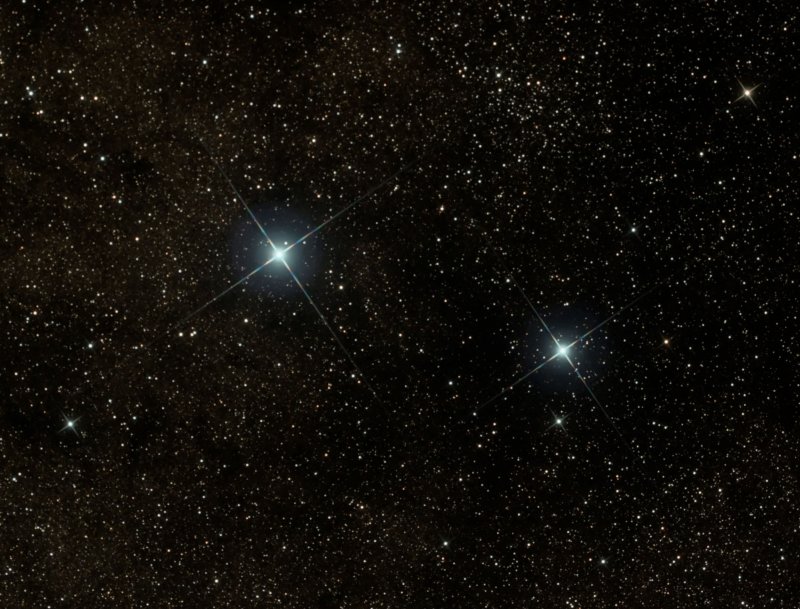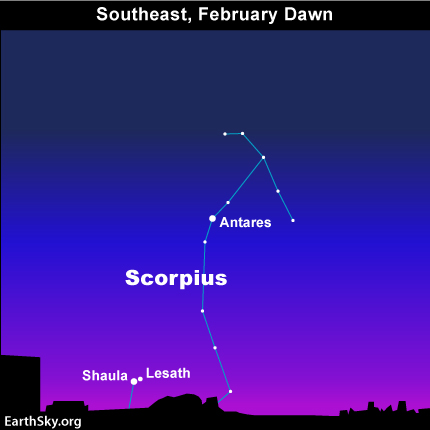
Shaula and Lesath. Photo via John Glossop.
Tomorrow – February 2, 2018 – is Groundhog Day, the day on which the legendary groundhog seeks his shadow as a forecast of whether spring will come early or late. Whatever the groundhog says … you can look east before dawn now for another sign of spring. It’s the two stars that represent the Stinger in the constellation Scorpius the Scorpion. We call them Shaula and Lesath. From mid-northern latitudes, in the cold dawn of February, the sighting of these stars announces that the winter landscape is about to awaken from its long dormant slumber: that spring is on its way.
For the Pawnee, who roamed the prairie lands of Kansas and Nebraska, the sky was a calendar, and the stars foretold the change of seasons. The Pawnee saw a snake in the stars forming the front part of Scorpius. But the stars of the stinger were, for the Pawnee, a pair of ducks.
It’s thought that the Pawnee called the stars on the Scorpion’s stinger the Swimming Duck stars. When the Swimming Ducks came into view in the southeast – prior to daybreak in the month of February – the Pawnee recognized that it was time to begin planting ceremonies. In other words, they were a sign of hope, and a sign that spring was on its way.
In a dark sky, you can see that the starlit band of the Milky Way runs behind Shaula and Lesath in the Tail of Scorpius. Photo via Daniel McVey. Visit his website.
These stars are now coming into view at or shortly before dawn.
You’ll need a clear, unobstructed view to the south to southeast to spot Scorpius’ stinger stars – Shaula and Lesath – flickering by the horizon. If you miss seeing these stars tomorrow, or the next day, try again later in February.

If you’re in the Northern Hemisphere, Shaula and Lesath will come over your southeastern horizon before dawn sometime this month. They’re a hopeful sign that spring is coming.
In some respects, we can regard the search for the Swimming Duck stars as a Pawnee version of Groundhog Day.
The return of the Swimming Ducks to the morning sky signaled the first stirrings of the great plains from hibernation. Shaula and Lesath’s presence over the horizon was symbolic of waterfowl breaking through the ice.
As we approach the end of winter, Shaula and Lesath will appear higher each morning in the southeast before dawn. Their morning appearance tells us that the prairie is about to awaken to the rolling thunders of spring.
By the way, for us today, the stars at the end of the Scorpion’s tail are also known as the Cat’s Eyes. They’re easy to spot at the J-shaped star pattern that forms the constellation Scorpius.
Enjoying EarthSky so far? Sign up for our free daily newsletter today!
Bottom line: Go ahead. Treat yourself to something beautiful, and hopeful. Get up early on some morning this February, and look for the Scorpion’s stinger stars near the horizon.
from EarthSky http://ift.tt/16kLBGt

Shaula and Lesath. Photo via John Glossop.
Tomorrow – February 2, 2018 – is Groundhog Day, the day on which the legendary groundhog seeks his shadow as a forecast of whether spring will come early or late. Whatever the groundhog says … you can look east before dawn now for another sign of spring. It’s the two stars that represent the Stinger in the constellation Scorpius the Scorpion. We call them Shaula and Lesath. From mid-northern latitudes, in the cold dawn of February, the sighting of these stars announces that the winter landscape is about to awaken from its long dormant slumber: that spring is on its way.
For the Pawnee, who roamed the prairie lands of Kansas and Nebraska, the sky was a calendar, and the stars foretold the change of seasons. The Pawnee saw a snake in the stars forming the front part of Scorpius. But the stars of the stinger were, for the Pawnee, a pair of ducks.
It’s thought that the Pawnee called the stars on the Scorpion’s stinger the Swimming Duck stars. When the Swimming Ducks came into view in the southeast – prior to daybreak in the month of February – the Pawnee recognized that it was time to begin planting ceremonies. In other words, they were a sign of hope, and a sign that spring was on its way.
In a dark sky, you can see that the starlit band of the Milky Way runs behind Shaula and Lesath in the Tail of Scorpius. Photo via Daniel McVey. Visit his website.
These stars are now coming into view at or shortly before dawn.
You’ll need a clear, unobstructed view to the south to southeast to spot Scorpius’ stinger stars – Shaula and Lesath – flickering by the horizon. If you miss seeing these stars tomorrow, or the next day, try again later in February.

If you’re in the Northern Hemisphere, Shaula and Lesath will come over your southeastern horizon before dawn sometime this month. They’re a hopeful sign that spring is coming.
In some respects, we can regard the search for the Swimming Duck stars as a Pawnee version of Groundhog Day.
The return of the Swimming Ducks to the morning sky signaled the first stirrings of the great plains from hibernation. Shaula and Lesath’s presence over the horizon was symbolic of waterfowl breaking through the ice.
As we approach the end of winter, Shaula and Lesath will appear higher each morning in the southeast before dawn. Their morning appearance tells us that the prairie is about to awaken to the rolling thunders of spring.
By the way, for us today, the stars at the end of the Scorpion’s tail are also known as the Cat’s Eyes. They’re easy to spot at the J-shaped star pattern that forms the constellation Scorpius.
Enjoying EarthSky so far? Sign up for our free daily newsletter today!
Bottom line: Go ahead. Treat yourself to something beautiful, and hopeful. Get up early on some morning this February, and look for the Scorpion’s stinger stars near the horizon.
from EarthSky http://ift.tt/16kLBGt

Aucun commentaire:
Enregistrer un commentaire